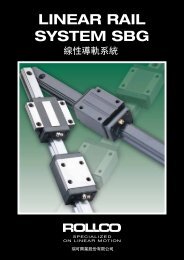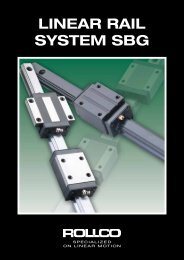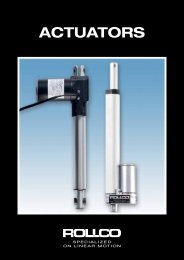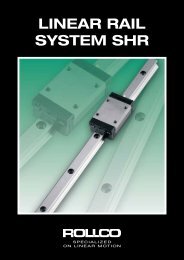Download PDF-brochure - Rollco
Download PDF-brochure - Rollco
Download PDF-brochure - Rollco
Create successful ePaper yourself
Turn your PDF publications into a flip-book with our unique Google optimized e-Paper software.
Technical Data<br />
technical data<br />
Load Rating & Life<br />
Under normal conditions, the linear rail system can be damaged by metal fatigue as the result of repeated<br />
stress. The repeated stress causes flaking of the raceways and steel balls. The life of linear rail system is<br />
defined as the total travel distance that the linear rail system travels until flaking occurs.<br />
The nominal life is defined as the total distance of travel (L=km) without flaking by 90% of a group of an<br />
identical group of linear rail systems operating under the same condition.<br />
C<br />
( )<br />
3<br />
Nominal life (km): L = x 50 km<br />
P<br />
Life Calculation<br />
The equation of nominal life for linear rail system is shown as below.<br />
Calculation of nominal life<br />
L (km) : Nominal life<br />
PC(N) : Calculated load<br />
C (N) : Basic dynamic load rating<br />
fC : Contact factor<br />
fW : Load factor<br />
L: Nominal life<br />
P: Load<br />
C: Basic dynamic load rating (N)<br />
The basic dynamic load rating C is a statistical number and it is based on 90% of the bearings surviving<br />
50 km of travel carrying the full load.<br />
Basic Static Load Rating : Co (N)<br />
If an excessive load or shock is applied to the linear rail system in the static or dynamic state, permanent<br />
but local deformation can occur to the steel balls and raceway. The Basic Static Load Rating is the maximum<br />
load the bearing can accept without affecting the dynamic life. This value is usually associated with<br />
a permanent deformation of the race way surface of 0.0001 time the ball diameter.<br />
Static Permissible Moment : Mo (Nm)<br />
Contact factor (fc)<br />
When two or more blocks are used in close<br />
contact, it is hard to obtain a uniform load<br />
distribution because of mounting errors and<br />
tolerances. The basic dynamic load C should be<br />
multiplied by the contact factors fc shown here.<br />
Load factor (fw)<br />
Reciprocating machines create vibrations.<br />
The effects of vibrations are difficult to<br />
calculate precisely. Refer to the following table<br />
to compensate for these vibrations.<br />
Number of blocks in close<br />
contact<br />
Contact factor fc<br />
Normal condition 1,0<br />
Vibration and<br />
impact<br />
Very slight<br />
Slight<br />
2 0,81<br />
3 0,72<br />
4 0,66<br />
5 0,61<br />
6 or more 0,6<br />
Velocity<br />
Very low<br />
V 0,25 m/s<br />
Low<br />
0,25 V 1,0 m/s<br />
Load factor fw<br />
1 ~ 1,2<br />
1,2 ~ 1,5<br />
These load are maximum moments or torque<br />
loads that can be applied to the bearing without<br />
damaging the bearing or affecting subsequent<br />
dynamic life.<br />
Moderate<br />
Strong<br />
Medium<br />
1,0 V 2,0 m/s<br />
V<br />
High<br />
2,0 m/s<br />
1,5 ~ 2,0<br />
2,0 ~ 3,5<br />
Mro : Moment in rolling direction<br />
Mpo : Moment in pitching direction<br />
Myo : Moment in yawing direction<br />
Temperature<br />
Please contact us if you need linear rail system with over 80°C working condition.<br />
30<br />
31








